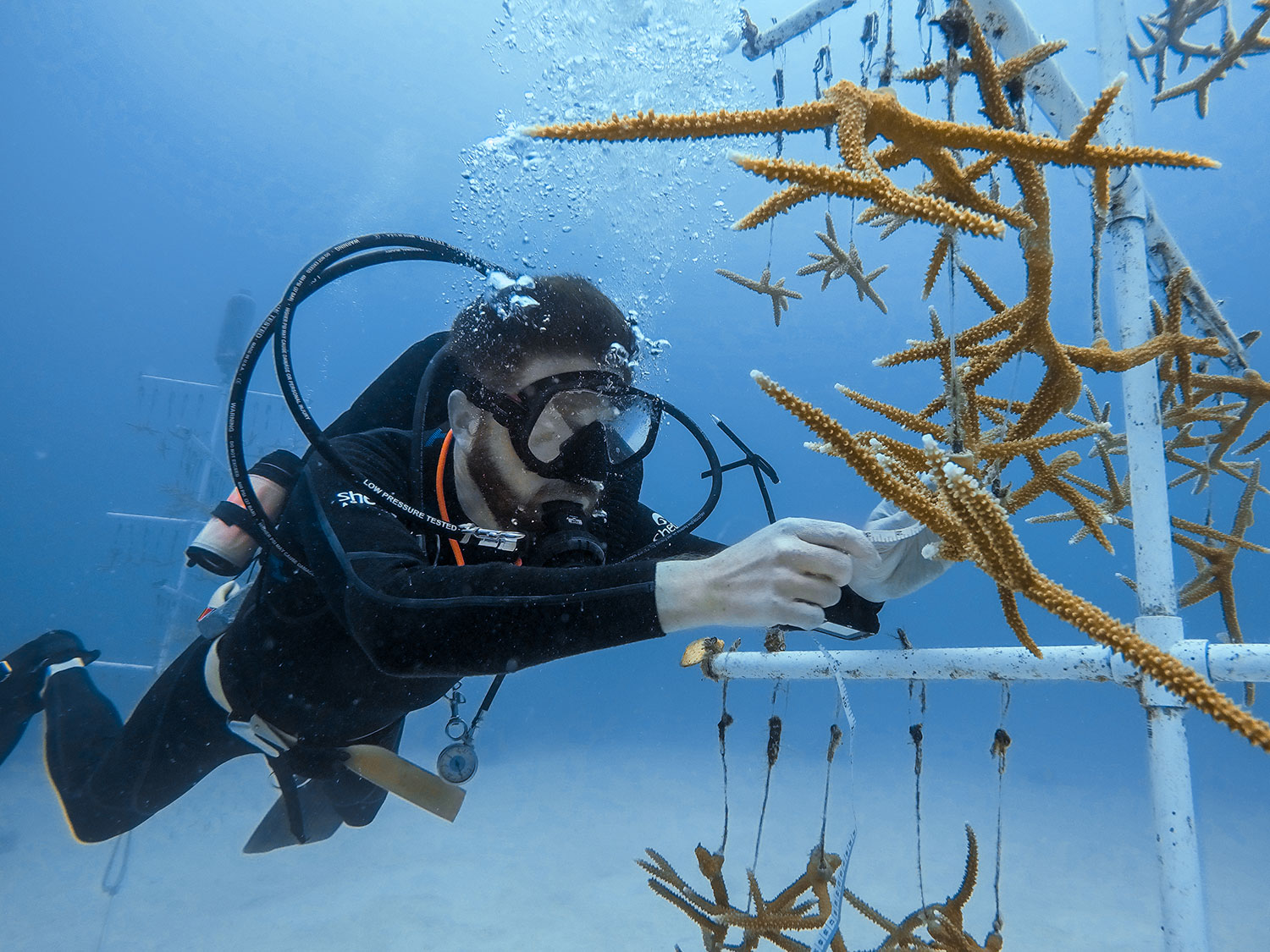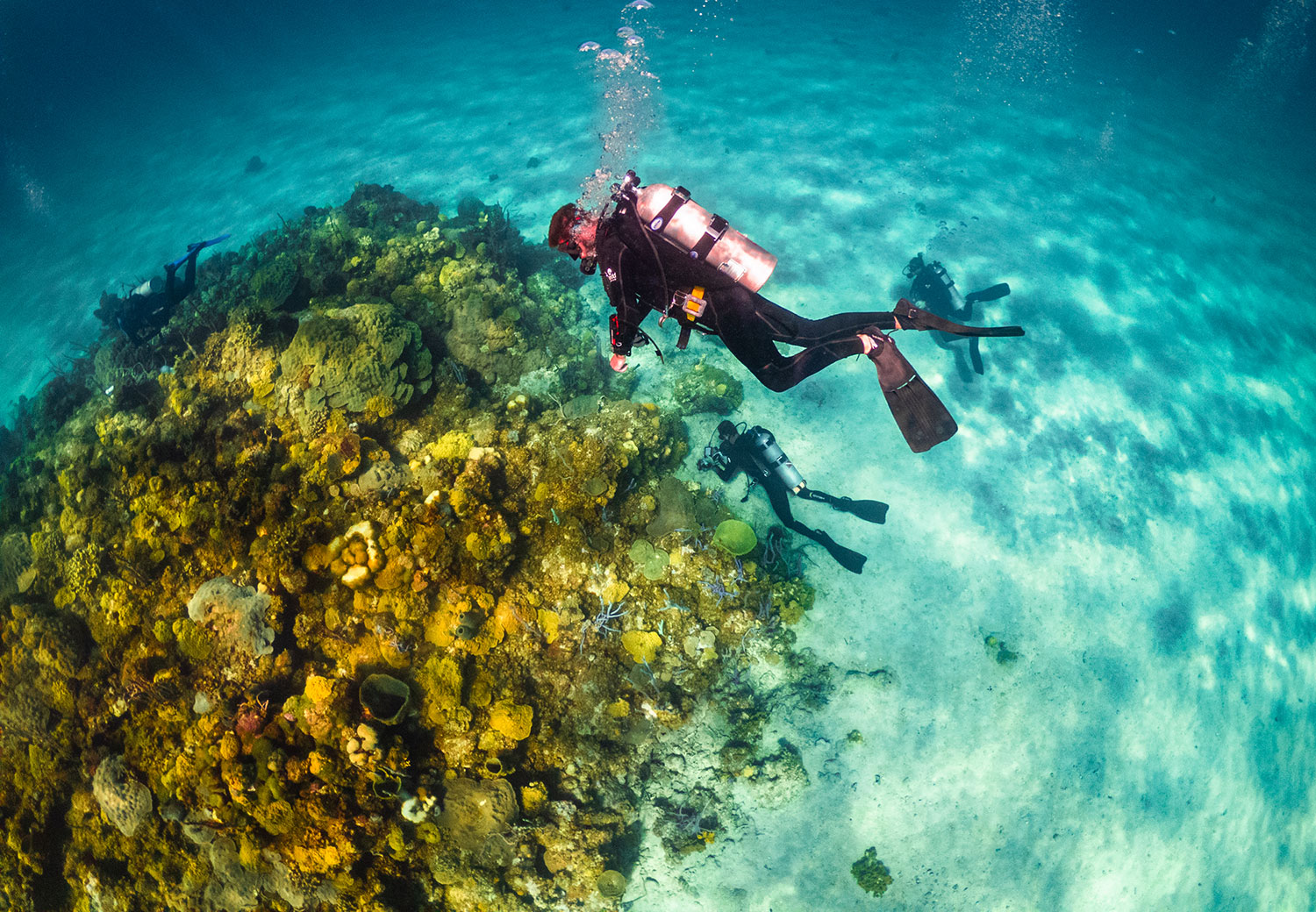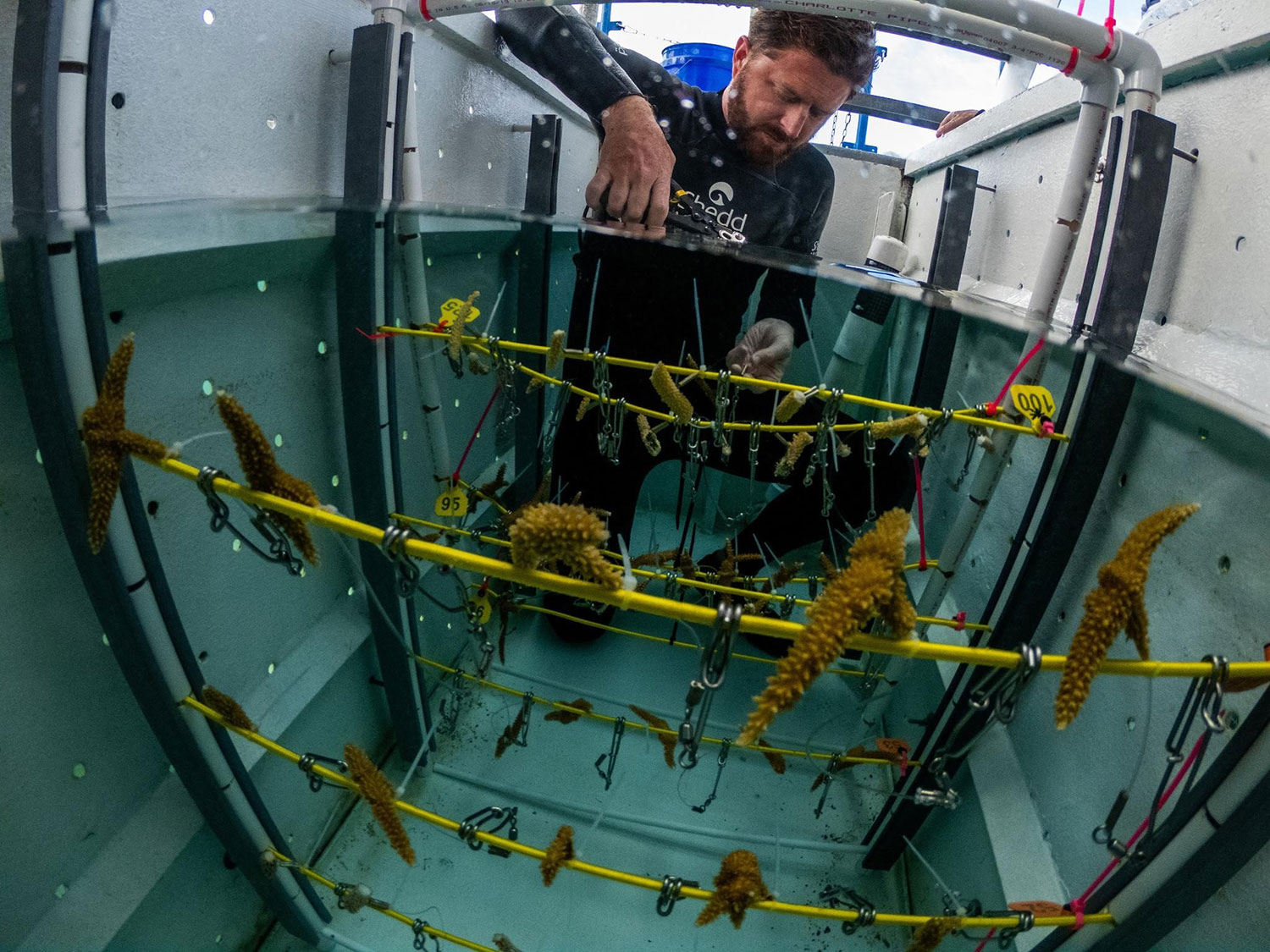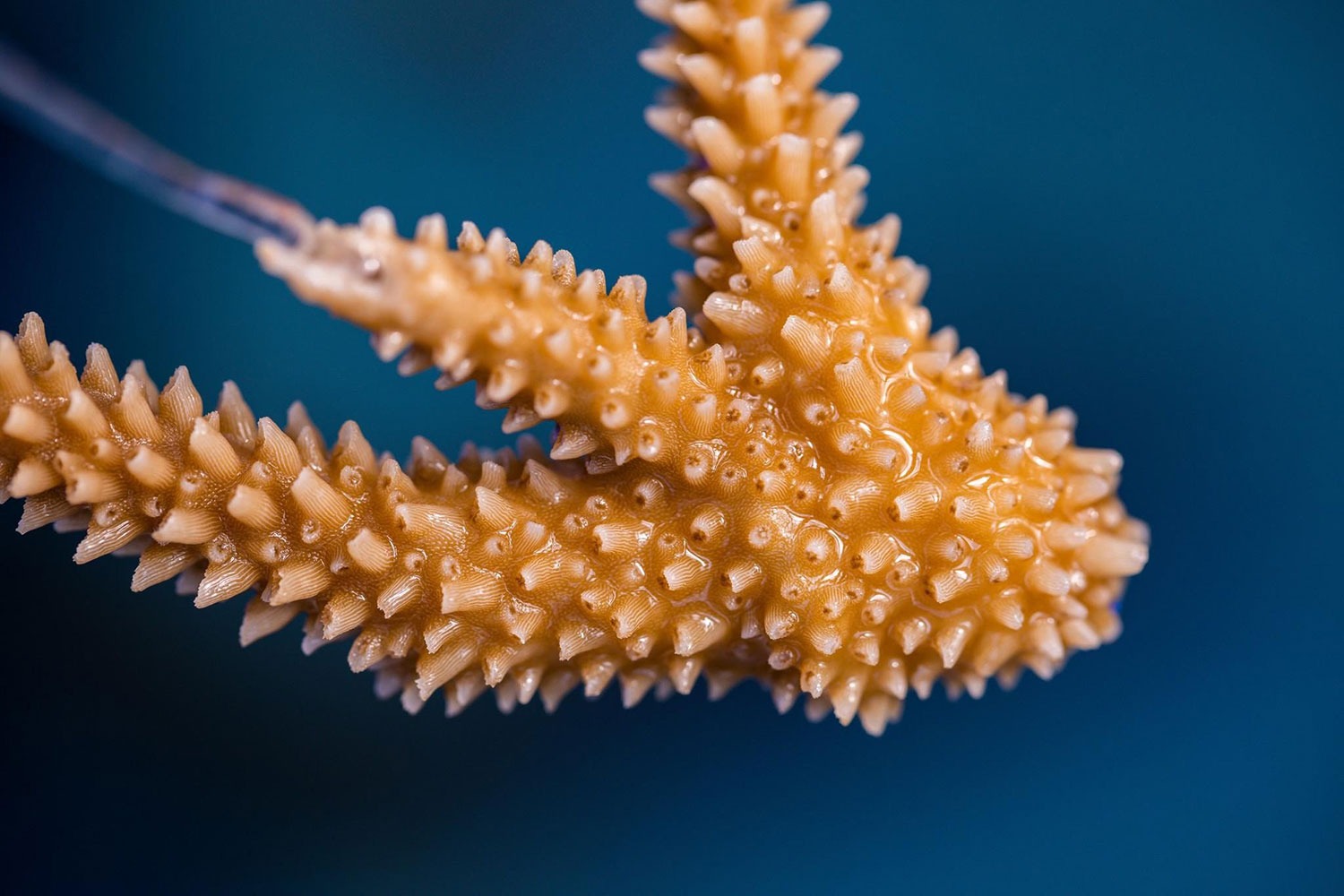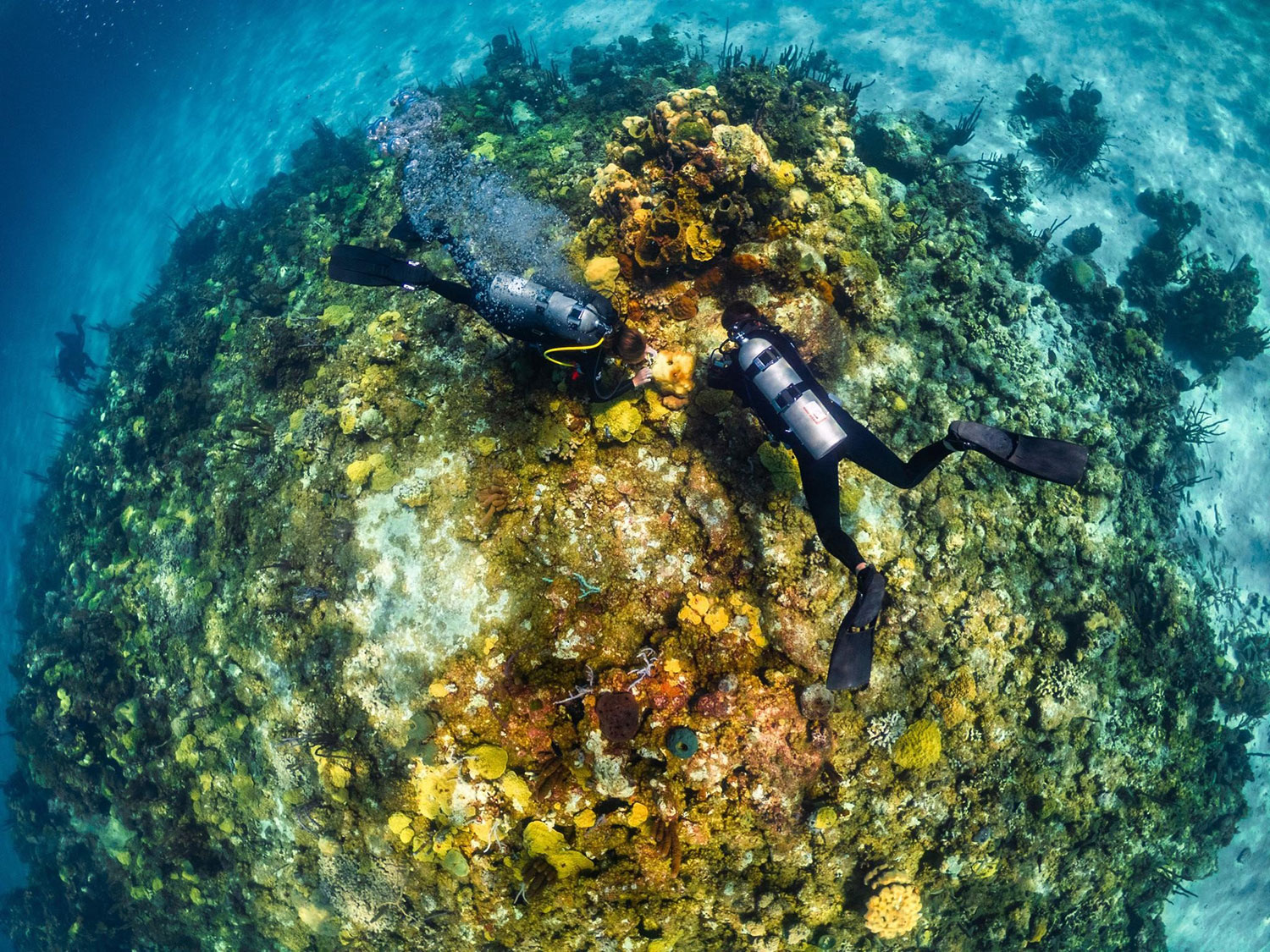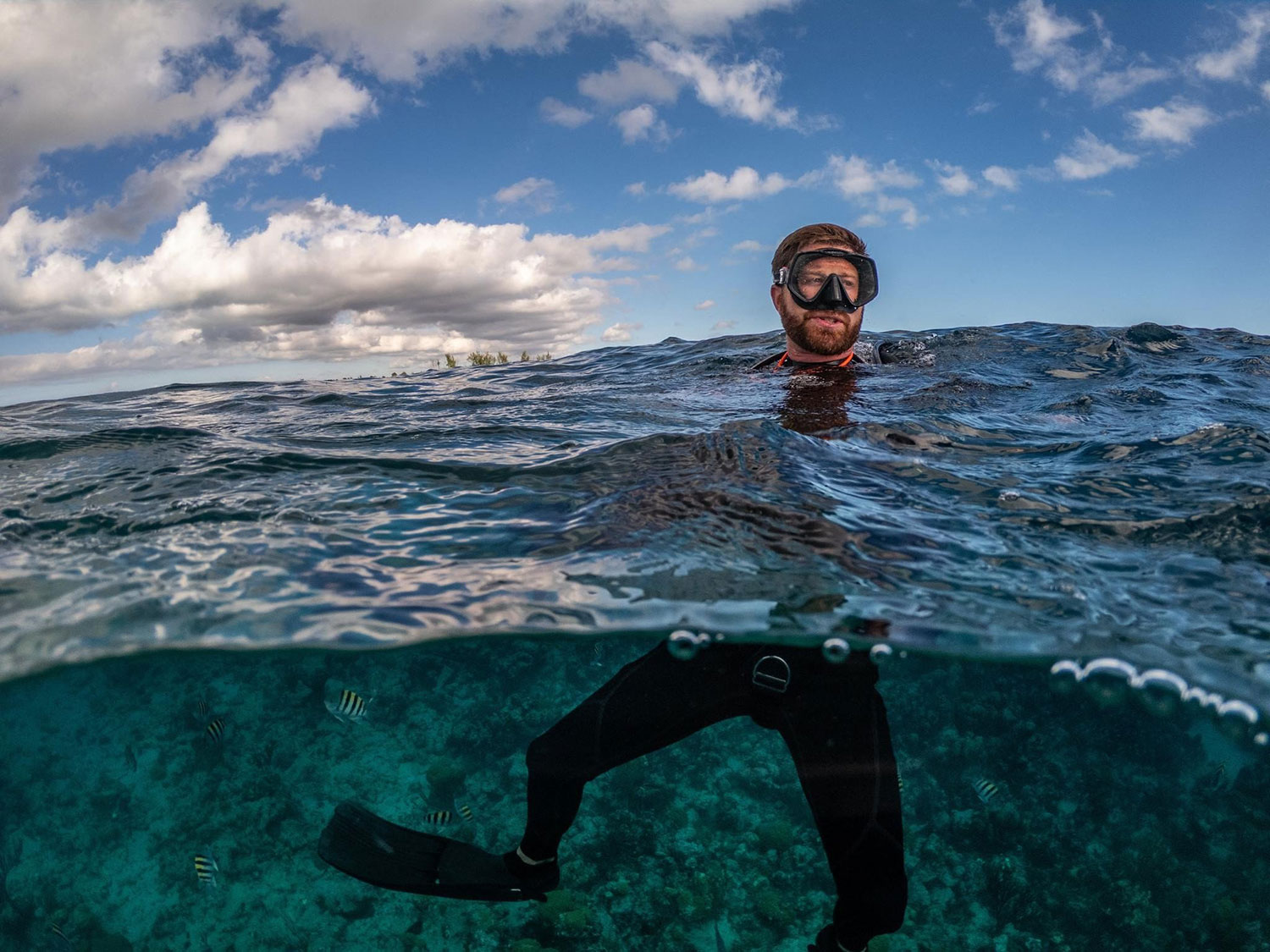Just beyond the entrance hall, two massive stone pillars mark the gateway to Chicago’s Shedd Aquarium. Underneath a high, domed ceiling is the 360-degree Caribbean Reef exhibit, the Shedd’s eye-catching first stop. Eager visitors circle the 90,000-gallon tank, marveling at the sharks, sea turtles, rays, and fish of all colors and sizes, darting and looping their way through stony crags and patches of coral.
The Caribbean Reef is the epicenter of the entire aquarium. From here hallways branch off in every direction, leading to exhibits focused on everything from Lake Michigan to the Amazon River. Stairways lead down to the oceanarium, where dolphins and beluga whales delight audiences, and to the Wild Reef, with its zebra sharks and moon jellies.
It is from a camouflaged door, hidden within a mural, that Dr. Ross Cunning first emerges. Cunning is a coral reef researcher, one of only eight research experts employed by the aquarium. Dressed in a casual button-down shirt, it would be difficult to tell at first glance that he is an important figure here, not one of the two million visitors the Shedd receives annually. Cunning is determined to preserve coral reef ecosystems, not just in exhibits as relics of a bygone era, but by saving the reefs that exist within our oceans.
Coral reefs have long been threatened by human activity, but climate change is imperiling the very survival of these fragile ecosystems—and making Cunning’s work all the more urgent. Rising sea temperatures have been documented all over the world, but particularly at the shallow depths that corals must inhabit. The temperature of the top 700 meters of our global oceans has risen by 1.5 degrees Fahrenheit in the last century. While that may not sound like much, it has devastated coral reefs. Between 2008 and 2019, 14 percent of the world’s coral reefs were lost. According to the Global Coral Reef Monitoring Network, between 70 and 90 percent of coral could be gone by the end of the century.
Cunning is devoted to saving these rapidly disappearing corals. Under the feet of unsuspecting aquarium visitors and more than a thousand miles from the nearest coral reef, Cunning is working to identify coral species that can withstand warmer temperatures. At stake is the future of these crucial organisms—and the ocean as we know it.
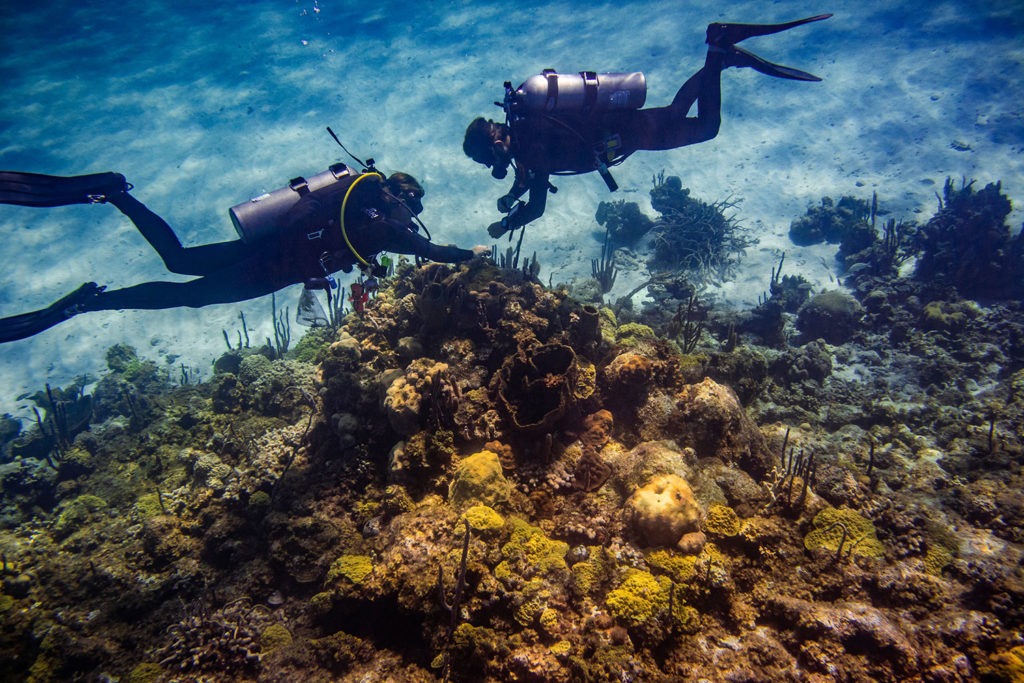
Growing up in Indiana, Cunning took an early interest in science. But coral reefs didn’t catch his attention until his undergraduate days at Duke. “I was a junior in college studying biology and environmental science but didn’t know what I wanted to do with that degree,” Cunning recalls. He elected to spend a summer studying abroad in Australia on the Great Barrier Reef, and after obtaining his scuba certification and spending every day snorkeling for a research project, he was hooked.
Cunning hasn’t looked back. He took every marine science course available, and soon he was off to the University of Miami for a Ph.D. program. There he was surrounded by people with a similar passion, in one of the only places in the entire country with ready access to a reef. “It was amazing to be part of a larger research department with a lot of people working on coral reefs,” Cunning says. “You just get more energy, more collaboration.”
At Miami, Cunning started to focus on the crucial relationship between corals and the algae that inhabit them. “Each coral has over a million of these single-celled algae, these zooxanthellae, per [square] centimeter of coral,” he explains. These algae are crucial to sustaining the ecosystem around coral reefs.
Contrary to what many people think, corals are animals, not plants. The plant-like structures that we see are actually the exoskeletons of many tiny animals called polyps, which clump together around a solid anchor, like a rock, and begin to produce their exoskeletons.
To produce these vital exoskeletons, corals need nutrients. “The waters in the tropics are very nutrient poor, so there isn’t enough stuff floating around for corals to just pick and eat,” explains Dr. John Parkinson, a frequent collaborator of Cunning’s and an assistant professor at the University of South Florida. Instead they rely on algae’s crucial ability to photosynthesize, producing sugars and oxygen that coral desperately needs. As much as 80 to 90 percent of the nutrients these algae produce are used by their host corals.
In return, corals provide shelter for the typically sediment-dwelling algae. Inside coral tissue, algae are protected from predators and closer to the light they need to photosynthesize. “They produce millions of copies of themselves asexually within a coral,” Parkinson says. Healthy individuals can then disperse and help maintain the population. The algae also consume the waste molecules that corals produce, such as nitrates, creating a reciprocal nutrient exchange.
Yet as the temperatures of oceans rise, these relationships crumble. Too much light and heat can break the apparatuses algae use to photosynthesize, leading to excess oxygen—more than corals can handle. With the symbiosis fractured, corals expel their algae, triggering a process called coral bleaching. The corals turn colorless, lose their pigments, and become brittle. In this stage, they are on the verge of death.
The result is devastating for oceans as a whole. Coral reefs only make up 0.2 percent of the total seafloor, but roughly 25 percent of all marine life depends on coral reefs at some point in their lives. Four thousand distinct fish species rely on coral reefs.
The Great Barrier Reef, for instance, experienced severe bleaching events in both 2016 and 2017. The Australian Institute of Marine Science has said that between those two years, two thirds of the overall reef were damaged.
Cunning’s dissertation at the University of Miami raised questions about the complex relationships between coral and algae. Why is it, for instance, that certain corals house a variety of algae species, while other corals only have one? It wouldn’t be long before exactly those questions would become incredibly relevant on a global scale.
“It turns out that the particular species of symbiotic algae within a coral is a big determinant of its thermal tolerance,” Cunning says. Some species of algae can elevate the bleaching threshold of their host coral by as much as 1 to 2 degrees Fahrenheit, a significant margin that can help corals navigate rising ocean temperatures.
Coral reefs only make up 0.2 percent of the total seafloor, but roughly 25 percent of all marine life depends on coral reefs at some point in their lives.
In a rapidly warming world, seemingly small temperature changes can make a huge difference. Working on his dissertation, Cunning examined which corals housed these heat-resistant algae, and whether those that didn’t could be enticed to do so for the sake of their own survival.
Cunning brought these questions with him on his various career stops, and in 2018 he landed at the Shedd Aquarium. Along the way, the ideas behind his research have shifted slightly. “I’m still working on those algae, but I’ve also expanded to try to understand what the contribution is of the coral itself,” Cunning says. “It’s the crossover between the genetics of the coral and the [algae] that determine the overall thermal tolerance of the coral.” Maximizing the heat tolerance of both algae and coral could be the difference between saving coral reefs or losing them forever.
To determine how different corals might withstand heat, Cunning and his team—he recently hired a postdoc and a research technician—must venture out into the field. Three times a year, they trek down to the warmer climates of Florida or the Bahamas. Once there, they board the R/V Coral Reef II, a research vessel specially designed and built for the Shedd Aquarium. Initially intended for animal collection decades ago, it has since become almost entirely devoted to the multitude of research projects spearheaded by marine scientists at the aquarium.
While on board the Coral Reef II, Cunning and his team make use of a technology called the Coral Bleaching Automated Stress System, or CBASS for short. Cunning shows me a CBASS machine housed at the Shedd, where they’re assembled. Water is collected into a plain green cooler, and the temperature of the seawater inside is regulated closely. Four probes and two aquarium heaters attached to the sides cool or heat the water, and a computer display on top reads out the current water temperature. “We can program the water temperature to follow whatever profile we want,” Cunning says. The team then collects data about how different strains of coral react as the temperature of the water increases around them. The team can have as many as eight coolers onboard the Coral Reef II, allowing researchers to test up to 45 strains of coral at a time.
In 2020, Cunning co-authored a paper focusing on a shallow reef in the Bahamas that avoided the bleaching that devastated its neighbors. Its corals and algae are more accustomed to warm ocean temperatures, making it an important case study, but the overall genetic diversity of the Bahama reef is low.
Another paper examined staghorn corals using CBASS technology. “We tested over 200 strains of staghorn coral, which is an endangered species and an important reef-builder in the Caribbean,” Cunning explains. “It’s the primary species that is grown in coral nurseries in Florida.”
Coral nurseries are often just PVC pipe contraptions floating out in the ocean, anchored in the sand. Each one looks like a crude underwater tree, with various pipes acting as branches. Corals grow on each branch, often suspended underneath like living Christmas tree ornaments. Using buoys, researchers like Cunning and Parkinson can test these nurseries at different depths and environments.
These are the coral that will then be reintroduced to reefs in hopes of restoration. But while identifying the most heat-resistant species is a priority, the team’s findings could also help conserve less thermally tolerant corals. “They could be planted at cooler reef locations or deeper sites that are less likely to experience thermal stress and bleaching, so they also have the best chance at survival,” Cunning says.
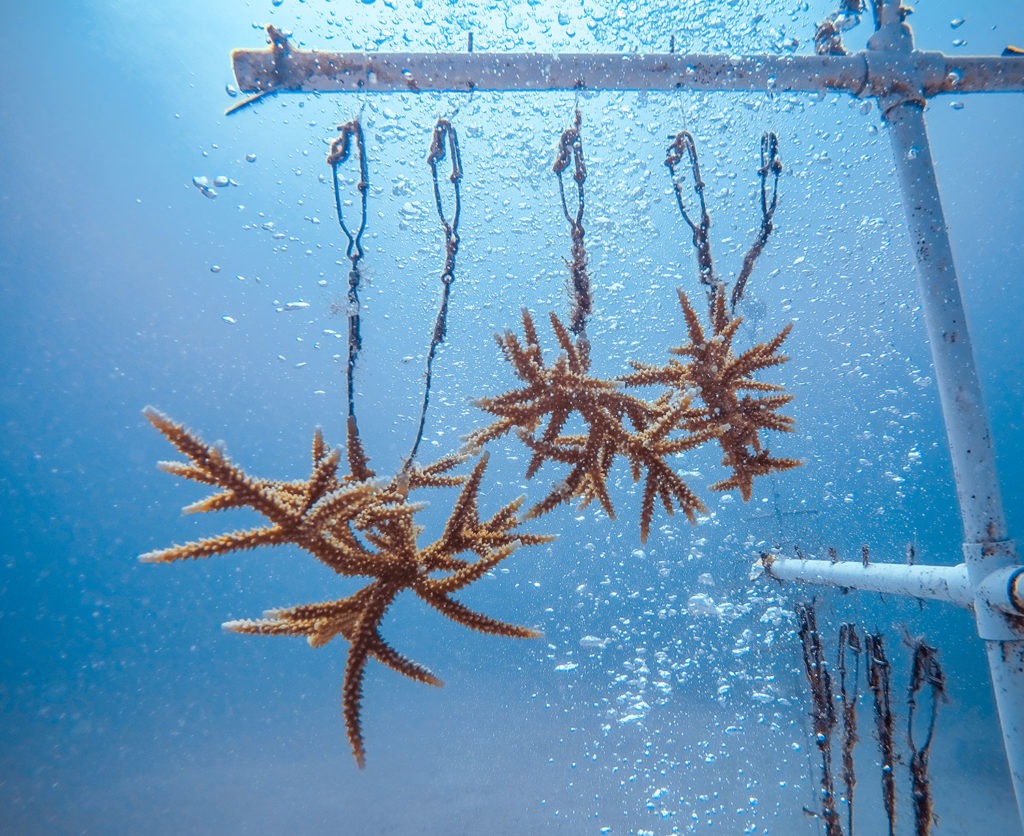
As we traverse through the aquarium’s halls, Cunning admits that navigation can be tricky. “Are you lost yet?” he asks. There’s no question that I am. Away from the hubbub, the walls are fairly mundane, and it feels as though there are corridors splitting off in every direction.
Cunning takes me into the Molecular and Microbial Ecology Lab, where he conducts genetic testing of bacteria. Cunning analyzes samples of corals to identify the species of bacteria housed within their tissues. When he isn’t in the field, Cunning is often conducting DNA testing in the molecular lab and a conservation research lab deep within the maze of tunnels underneath the aquarium. Coral researchers are interested in identifying the specific genes within the genetic strains of both corals and algae that might determine heat resistance.
After the lab, we head to a pitch black room. Every light is turned off, and huge machinery roars overhead. Pipes and vents and containers loom out from every direction, and an eerie blue glow emanates from the back.
These are the coral holding tanks, far from the public eye. Because coral is a collection of the exoskeletons of many different polyps, pieces can be broken off and repopulated elsewhere without harming the original specimen. In these tanks, some corals have been living for decades, their branches trimmed every so often for public display upstairs. In that sense, Cunning explains, corals are much like trees, as their branches can be used to propagate new individuals. For now, these are display corals. Soon, though, Cunning hopes to bring coral specimens back from his trips to Florida and the Bahamas, for onsite experimental research, and house them in this room.
As we emerge from the dark room, Cunning shares with me that the Wild Reef exhibit has been upgraded to include sections about climate change and coral bleaching. “That’s another reason why doing this work at the aquarium is so great,” Cunning says. “We have such a large public audience that we engage with.”
The Wild Reef section of the aquarium is beginning to reflect these efforts. Tanks show coral growing much the same way as they do downstairs in the holding tanks, and nursery replicas hang from the ceiling above visitors’ heads. A huge photograph covers one wall, showing Cunning and his team conducting fieldwork. A screen will soon display a video explaining why aquarium guests should care about these ecological developments.
This engagement is important, because corals can tell us a great deal about the health of our oceans. Corals are uniquely sensitive to changes in temperature, making them some of the first organisms to feel the effects of climate change. “[Corals] evolved over a very long time to be optimized for the temperatures that they are used to,” Parkinson explains. There is a very small sliver of temperatures that are acceptable for corals, and we’re quickly moving out of that range. That corals are feeling the heat indicates that many more species are about to as well.
“The most important thing to ensure the survival of coral reefs is that we take action on climate change,” Cunning says. Coral reefs are in grave danger, and it all starts with the bigger picture. “All the research that we’re doing can help, and it is helping give corals a little bit of a boost, but if the ocean keeps warming, if we don’t do anything about the underlying problem, all this research we’re doing is going to be for naught.”
We part ways, and Cunning disappears back into the labyrinth of the aquarium’s backstage. There is more work to be done.



